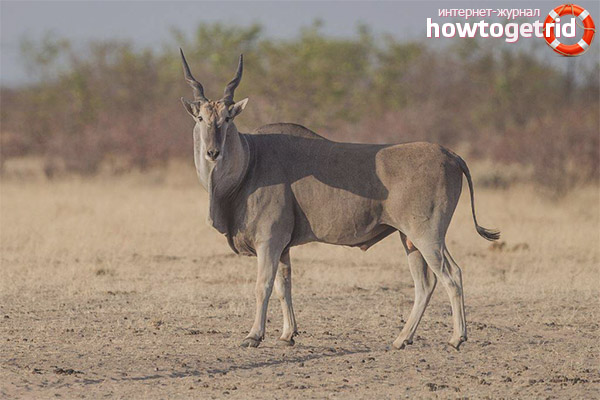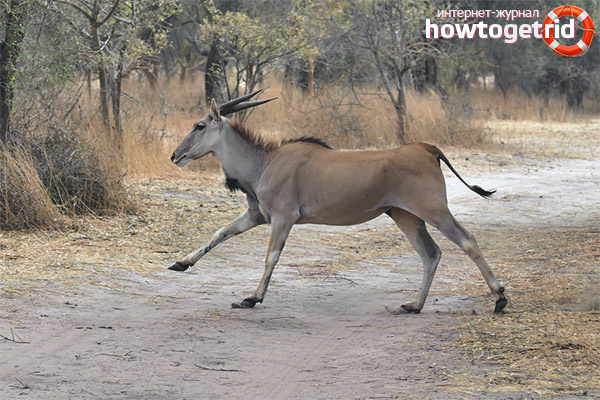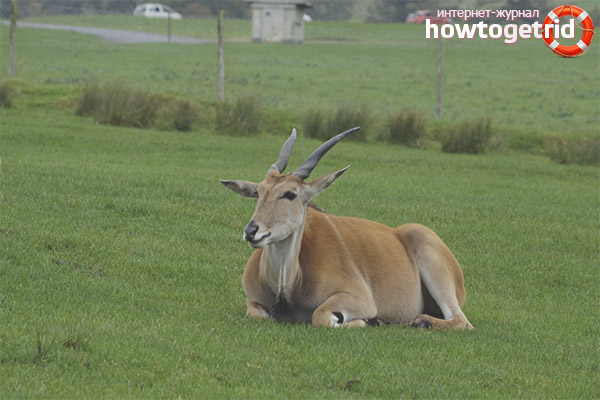The content of the article
In ancient times, there were a lot of cannes on the territory of the African continent. But now antelopes of this species, which are similar in appearance to tours, live only in nature reserves and some national parks.
Appearance
These are cloven-hoofed animals that belong to the bovine family. Cannes antelopes have a body length of 205 to 340 cm. These are large animals, they have very long horns. In males they have a length of about 1.2 m, and in females - 60-70 cm. The height of the antelope is 1.5-1.8 m. The average body weight is 460-670 kg, but an adult male can weigh up to 940 kg .
Their coat has a buffy color, but with age it becomes more gray. Older males have a dark gray coat. When molting, their hair falls to shreds. A dark stripe runs along the spine, and thin white strips run from it along the ribs. At the end of the tail, these animals have a black tassel.
Their horns are twisted in a spiral. In males, they are slightly bent at the tips. The head is narrow, the nose is long and narrow enough. The ears are pointed.
Curly bangs grow in males in the forehead. Near the edge of the eye, they often have 2 white stripes. Both females and males have a short mane on their backs. The skin on the neck folds.
Where do they live
These animals live today on farms and in the reserves of Africa, located in the center and in the east of the continent. But on the Draken ridge, which is located in southern Africa, a population of these animals lives.
Breeding
Cannes have a pregnancy duration of 9 months, but sometimes it can last several weeks less. As a rule, 1 cub is born in a female.
Usually the mating season begins in December or January. During this period, several females are combined into a herd. Together they begin to attract males. The right to mate is obtained only by the strongest representative, who conquers it by winning the battle.
Before giving birth, the female seeks refuge in dense thickets of bushes. A calf is born into the world weighing 23-35 kg. During the first month of his life, he does not leave the shelter in which he was born. The female comes to him several times a day to feed him. When the calves are already strong enough, they become full members of the herd. Mother and cub constantly communicate through various sounds.
The female feeds the calf with milk until the age of five months. But throughout the first year of her life, the mother takes care of him. Young female cannes remain in their herd for a very long time.
Young males acquire their distinctive features only after they reach puberty. They differ from females in that they have a very powerful trunk, they have a fold of skin on their throats, and the withers are raised.
Lifestyle
Cannes antelopes live in herds. In the wild, they can live up to 10 years, but when kept in captivity, their life expectancy increases significantly, and can reach 25 years.
Cannes prefer an open area. It can be both mountains and semi-deserts. They live in rare forests, on the plains where shrubs grow, and also in the savannahs. The herd usually consists of 30-70 individuals, but during the migration period the number can reach 1000. As a rule, the group consists of females and cubs. At the head of the herd are 2 males. When drought sets in, these animals migrate to lands that are closer to the river valleys.These antelopes move around the territory to find food.
They always behave wary, which is understandable for harsh African conditions. A person in an open area cannot approach these animals closer than 450-500 m.
There are 9 species of antelopes that have spiral horns.
Enemies
Adults can fall prey to only a lion. Young antelopes are attacked by hyenas, cheetahs and leopards. Females often fight cheetahs to protect their young.
Nutrition
These animals are not very finicky. Food for them are leaves, fresh shoots, as well as branches of shrubs and trees. In exceptional cases, they can eat grass, but they choose the freshest and juiciest from it. This is due to the fact that the structure and shape of their teeth is more suitable for chewing leaves. Their grass is less suitable for grass. In hot weather during the day, cannes can calmly stand in the shade, slowly chewing their food.
In the morning and in the late afternoon, when it is not very hot, they graze across the territory. If it is very hot even at this time of day, they may seek food at night.
Looking for food, these antelopes constantly move around the territory. They walk along the savannahs and plains to find lush foliage. If leaves are not enough for them, then they can also eat the bark of trees, some kind of grain or fruits. To get tubers or plant roots, they can dig up the soil. To get the foliage from a tall tree, the cannes bend the branches with horns.
Fact! These animals can live without water for quite some time. Their body receives moisture from food.
Human influence
A rapid decline in the number of representatives of the species was observed during the last century. This is due to the fact that the hunt was carried out too intensively. After all, when a person invented a weapon with which he can kill an animal at a great distance, the extermination of animals acquired a very large scale. The authorities in those states where Cannes antelopes reside did not protect these animals.
Another reason for the decline in numbers is the diseases that livestock carries. Cannes cannot cure them on their own.
Today we can see a large herd of these antelopes only in national parks. As early as the 19th century, attempts were made to domesticate animals of this species. There are about 2,000 breeding farms in Transvaal. They are grown to obtain valuable and nutritious meat and milk. Cannes milk is considered medicinal.
Interesting Facts
- Ancient drawings tell us that even in those days, people hunted for the eland antelope. Researchers found such images in the Kalahari Desert.
- One of the subspecies of these antelopes, the Western Cannes, has very long horns. Record - 120 cm.
- When the cannes run, you can hear a kind of knock, reminiscent of a click. Such a sound is made by the fingers of the animal, which hit each other. You can hear the clicking even from afar. The same sound can be heard when reindeers run.
- When a threat arises, cannes can jump very high, and overcome obstacles up to 2 m in height.
Security
Cannes used to inhabit vast areas of Africa. Due to active hunting and diseases, the number has greatly decreased. But representatives of this species successfully breed in captivity, which gives hope for the conservation of the species. Cannes have been living in reserves, parks and zoos for many years, successfully bringing offspring. Hunting for them is prohibited.












Submit